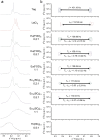Synthesis of lanthanide tag and experimental studies on paramagnetically induced residual dipolar couplings
- PMID: 35864525
- PMCID: PMC9306141
- DOI: 10.1186/s13065-022-00847-5
Synthesis of lanthanide tag and experimental studies on paramagnetically induced residual dipolar couplings
Abstract
Nuclear Magnetic Resonance (NMR) spectroscopy is an indispensable technique for the structure elucidation of molecules and determination of their characteristic interactions. Residual Dipolar Coupling (RDC) is an NMR parameter that provides global orientation information of molecules but necessitates the use of an anisotropic orientation medium for the partial alignment of the target molecule with respect to the magnetic field. Importantly, anisotropic paramagnetic tags have been successful as orienting media in biomolecular NMR applications but their use in small organic molecules remains imperfect due to challenges in designing functional lanthanide complexes with varying degrees of bonding in the Ln(III) inner coordination sphere. In this study, we propose a strategy for the synthesis of the lanthanide tag 4-mercaptomethylpyridine-2,6-dicarboxylic acid, 4-MMDPA and the measurement of RDCs in a target molecule using several paramagnetic lanthanide complexes.
Keywords: NMR spectroscopy; Paramagnetic lanthanide tag; Residual dipolar coupling; Spin quantum mechanics; Sulfur chemistry.
© 2022. The Author(s).
Conflict of interest statement
The authors declare that they have no competing interests.
Figures




Similar articles
-
Lanthanide Tagging of Oligonucleotides to Nucleobase for Paramagnetic NMR.Chembiochem. 2020 Dec 1;21(23):3333-3337. doi: 10.1002/cbic.202000417. Epub 2020 Aug 17. Chembiochem. 2020. PMID: 32687667 Free PMC article.
-
Design and applications of lanthanide chelating tags for pseudocontact shift NMR spectroscopy with biomacromolecules.Prog Nucl Magn Reson Spectrosc. 2019 Oct-Dec;114-115:284-312. doi: 10.1016/j.pnmrs.2019.08.002. Epub 2019 Aug 28. Prog Nucl Magn Reson Spectrosc. 2019. PMID: 31779884 Review.
-
Molecular Structure Refinement Based on Residual Dipolar Couplings: A Comparison of the Molecular Rotational-Sampling Method with the Alignment-Tensor Approach.J Chem Inf Model. 2024 Jun 24;64(12):4781-4801. doi: 10.1021/acs.jcim.4c00416. Epub 2024 Jun 11. J Chem Inf Model. 2024. PMID: 38861396
-
A Self-Assembled Oligopeptide as a Versatile NMR Alignment Medium for the Measurement of Residual Dipolar Couplings in Methanol.Angew Chem Int Ed Engl. 2017 Oct 9;56(42):12857-12861. doi: 10.1002/anie.201705123. Epub 2017 Sep 13. Angew Chem Int Ed Engl. 2017. PMID: 28834640
-
Residual Dipolar Couplings in Structure Determination of Natural Products.Nat Prod Bioprospect. 2018 Aug;8(4):279-295. doi: 10.1007/s13659-018-0174-x. Epub 2018 Jun 25. Nat Prod Bioprospect. 2018. PMID: 29943349 Free PMC article. Review.
References
-
- Saupe A. Recent results in the field of liquid crystals. Angew Chem Int Ed Engl. 1968;7(2):97–112. doi: 10.1002/anie.196800971. - DOI
LinkOut - more resources
Full Text Sources
